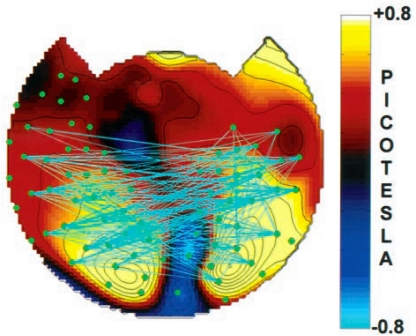Figure 1.
Results of a study of human whole-head magnetoencephalographic (MEG) signals evoked by visual stimuli that were binocularly rivalrous and frequency-tagged (Srinivasan et al., 1999). The topographic map indicates the magnitude of the MEG signal power at the frequency of the perceptually conscious dominant stimulus minus that at the same frequency when the same stimulus was non-dominant and non-conscious. Conscious perception of a stimulus was associated with a significant increase in the calculated coherence between distant MEG channels at the frequency of the perceived stimulus. Pairs of MEG channels whose coherence changed with change in percept are connected in the figure by cyan straight lines. These data point to a role for increased synchrony among distinct and distant neuronal groups in the Global Workspace during conscious perception. Presumably, these widespread groups constituting the Workspace contribute to the Dynamic Core.

